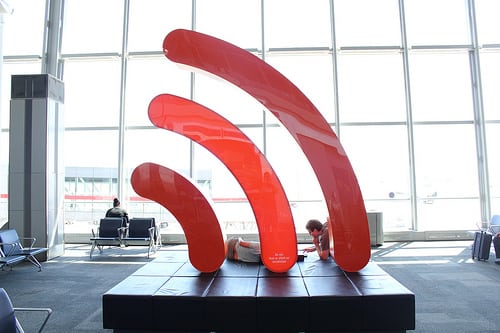Latest News

Could the Citizens Broadband Radio Service (CBRS) bandwidth replace Wi-Fi as the world’s common connectivity link? According to Preston Marshall, head of access for Google and director of the CBRS Alliance’s Enterprise Council, Wi-Fi and CBRS share many of the same characteristics. “At one point in history Wi-Fi was actually considered a ‘garbage band.’ Now, it’s one of the greatest economic drivers in the history of the world. CBRS has an even greater potential to create innovation for businesses in the United States and around the world,” he said.
CBRS represents shared spectrum at 3.5 GHz. During a series of presentations at the Connectivity Expo in Charlotte, North Carolina, the CBRS Alliance and other telecom organizations shared their visions of how CBRS spectrum will revolutionize the wireless economy. Marshall characterized CBRS as a type of spectrum with a much more flexible business model that is not constrained to specific applications. “CBRS is a venture-friendly bandwidth, providing businesses and entrepreneurs with fast, easy access to common spectrum,” said Marshall. “With CBRS, new businesses don’t have to wait to acquire spectrum. If they have a cool idea, they can launch it tomorrow, not next week.”
CBRS Alliance also has the political support of the Federal Communications Commission (FCC). Commissioner Michael O’Reilly was on hand to share how his agency will play a role in opening up mid-band access in the United States. “We’re paying very close attention to CBRS and mid-band spectrum and will be very aggressive in opening up more bandwidth for the wireless industry,” O’Rielly said during a presentation. “We ultimately want to combine 3.5 GHz with a shared 3.7 to 4.2 GHz C-band offering to create a solid play for wireless providers. We want the United States to win the race to 5G with free-flowing, private capital investment.”
Marshall refers to a three-tiered CBRS Spectrum Access System (SAS) developed by the FCC to securely share the bandwidth with government and commercial end users. The FCC’s SAS ensures that top priority for spectrum access is always given to “Tier 1” incumbent license holders such as military applications satellite Earth stations. If the spectrum isn’t being used, it would next be allocated to commercial users who buy Priority Access Licenses (PALs) covering a specific time and location. A third tier of low-priority General Authorized Access (GAA) users is then able to access between 80 MHz and 150 MHz of the bandwidth for the remaining available timeframes, providing easy, fast and low-cost connectivity.
The satellite industry and other tier-1 license holders view the SAS as a major concession, relinquishing a remarkable amount of control over a fixed resource at the center of their businesses. Counter to those beliefs, Wireless Innovation Forum CEO Lee Pucker asserts that the CBRS sharing system is smart and effective in the way it meets the specific needs of different users. “The SAS is consistent with the FCC’s current approach to connectivity — let industry and the markets determine accessibility on a basis of what makes sense for a majority of users,” he said. “And it makes perfect sense. Incumbents will always be and should be protected against interference. If others, however, need similar protections and priority access, they can apply and pay for a limited amount of available PALs. It doesn’t mean you get everything what you want, but it does give you better protection over general access licenses.”
That easy, low-cost access to underused and unused spectrum through the GAA tier could be a major factor in driving future Internet of Things (IOT) and 5G applications, according to Marshall. “Open access to CBRS can power indoor networks deployed in enterprises, hotels, airports and convention centers and adapt to the needs of outdoor applications running on fixed wireless deployments for smart cities and large outdoor campuses,” he said. “The win here for all parties is the shared infrastructure. We’re looking at looking at fixed as a natural component of the infrastructure. Everyone wants dense deployments at low costs. Google wants it so it can provide 4K over YouTube to more people. CBRS could be more valuable to the overall economy than all of LTE,” he said.
Marshall’s bold vision is now backed up by a comprehensive CBRS alliance marketing campaign to rebrand the bandwidth. Lisa Garza, director of product marketing for Federated Wireless, is working with the organization along with founding companies Google, Qualcomm, Ruckus Networks, Intel, Federated Wireless, and Ericsson to evangelize the concepts of CBRS technology and how LTE devices are going to coexist on a shared spectrum.
“After conducting a study and survey of potential bandwidth end-users, it was pretty clear that most of them didn’t really understand the term CBRS,” said Garza. “The acronym is a mouthful and hard to understand. That’s why we’re rebranding the bandwidth as ‘OnGo,’ and promoting it as ‘uncompromised connectivity.’ We’re focusing on the features that end-users understand — more options for enhanced customizability, to meet the specific needs of the Industrial Internet of Things (IIOT), In-Building wireless or connectivity in public spaces. We promote OnGo as enabling technologies that grab your attention.”
One of Marshall’s favorite applications is a 360-degree, real-time virtual reality NASCAR experience which puts consumers in a virtual stock racecar and provides data about their driving performance.
As a complement to the rebranding, CBRS Alliance developed a set of detailed specifications and an accompanying OnGo certification program, which aims to ensure seamless interoperability for all network components and devices, as well as to reflect the performance and interoperability standards that have been set and promised to customers.
“This is a new era for all of us,” said Marshall. “The 4G revolution was driven by applications and the 5G revolution will be driven by pure capacity. CBRS band is the first step into shared network concepts that I believe will ultimately realize the 5G vision.”
Get the latest Via Satellite news!
Subscribe Now